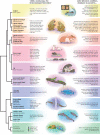Neural systems that facilitate the representation of social rank
- PMID: 35000438
- PMCID: PMC8743891
- DOI: 10.1098/rstb.2020.0444
Neural systems that facilitate the representation of social rank
Abstract
Across species, animals organize into social dominance hierarchies that serve to decrease aggression and facilitate survival of the group. Neuroscientists have adopted several model organisms to study dominance hierarchies in the laboratory setting, including fish, reptiles, rodents and primates. We review recent literature across species that sheds light onto how the brain represents social rank to guide socially appropriate behaviour within a dominance hierarchy. First, we discuss how the brain responds to social status signals. Then, we discuss social approach and avoidance learning mechanisms that we propose could drive rank-appropriate behaviour. Lastly, we discuss how the brain represents memories of individuals (social memory) and how this may support the maintenance of unique individual relationships within a social group. This article is part of the theme issue 'The centennial of the pecking order: current state and future prospects for the study of dominance hierarchies'.
Keywords: animal models; neural circuits; social learning; social rank.
Figures


References
-
- Chance MRA, Larson RR (eds). 1976. The social structure of attention. Hoboken, NJ: John Wiley & Sons Ltd.
-
- Freniere PL, Charlesworth WR. 1983. Dominance, attention, and affiliation in a preschool group: a nine-month longitudinal study. Ethol. Sociobiol. 4, 55-67. (10.1016/0162-3095(83)90030-4) - DOI
-
- Vaughn BE, Waters E. 1981. Attention structure, sociometric status, and dominance: interrelations, behavioral correlates, and relationships to social competence. Dev. Psychol. 17, 275-288. (10.1037/0012-1649.17.3.275) - DOI
Publication types
MeSH terms
Grants and funding
LinkOut - more resources
Full Text Sources

